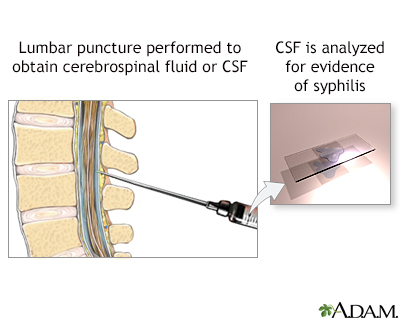Pregnancy SmartSiteTM
Venereal disease research laboratory slide test - CSF; Neurosyphilis - VDRL DefinitionThe CSF-VDRL test is used to help diagnose neurosyphilis. It looks for substances (proteins) called antibodies, which are sometimes produced by the body in reaction to the syphilis-causing bacteria. How the Test is PerformedA sample of spinal fluid is needed. How to Prepare for the TestFollow your health care provider's instructions on how to prepare for this test. Why the Test is PerformedThe CSF-VDRL test is done to diagnose syphilis in the brain or spinal cord. Brain and spinal cord involvement is often a sign of late-stage syphilis. Blood screening tests (VDRL and RPR) are better at detecting middle-stage (secondary or latent) syphilis. Normal ResultsA negative result is normal. False-negatives can occur. This means you can have syphilis even if this test is normal. Therefore, a negative test does not always rule out the infection. Other signs and tests may be used to diagnose neurosyphilis. What Abnormal Results MeanA positive result is abnormal and is a sign of neurosyphilis. RisksRisks for this test are those related to lumbar puncture, which may include:
Your provider can tell you about any other risks. ReferencesKarcher DS, McPherson RA. Cerebrospinal, synovial, serous body fluids, and alternative specimens. In: McPherson RA, Pincus MR, eds. Henry's Clinical Diagnosis and Management by Laboratory Methods. 24th ed. Philadelphia, PA: Elsevier; 2022:chap 30. Radolf JD, Tramont EC, Salazar JC. Syphilis (Treponema pallidum). In: Bennett JE, Dolin R, Blaser MJ, eds. Mandell, Douglas, and Bennett's Principles and Practice of Infectious Diseases. 9th ed. Philadelphia, PA: Elsevier; 2020:chap 237. | |
| |
Review Date: 8/26/2023 Reviewed By: Jatin M. Vyas, MD, PhD, Associate Professor in Medicine, Harvard Medical School; Associate in Medicine, Division of Infectious Disease, Department of Medicine, Massachusetts General Hospital, Boston, MA. Also reviewed by David C. Dugdale, MD, Medical Director, Brenda Conaway, Editorial Director, and the A.D.A.M. Editorial team. The information provided herein should not be used during any medical emergency or for the diagnosis or treatment of any medical condition. A licensed medical professional should be consulted for diagnosis and treatment of any and all medical conditions. Links to other sites are provided for information only -- they do not constitute endorsements of those other sites. No warranty of any kind, either expressed or implied, is made as to the accuracy, reliability, timeliness, or correctness of any translations made by a third-party service of the information provided herein into any other language. © 1997- A.D.A.M., a business unit of Ebix, Inc. Any duplication or distribution of the information contained herein is strictly prohibited. | |

 CSF test for syphi...
CSF test for syphi...
